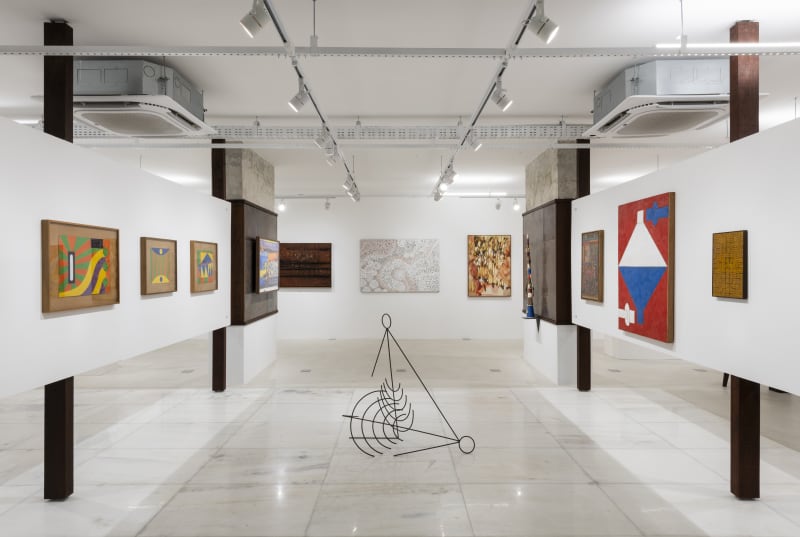Cais: curated by: Alana Silveira e Tomás Toledo
Cais [Quay] is the group exhibition that inaugurates the Salvador branch of Galatea, a gallery founded in 2022 in São Paulo, which has chosen the capital of the state of Bahia, Brazil's first capital, for its home outside the Southeast.
Being in Salvador is a testament to the gallery's ambition to reach a broader audience beyond the Southeast and to expand its interactions and connections with artists, curators, and intellectuals, especially in the Northeast—reaching beyond the Rio-São Paulo axis. This strategic move reflects and rearticulates the foundational conceptual pillars of Galatea's program: serving as a hub for the encouragement and convergence of different cultures, temporalities, styles, and genres, creating friction, reshuffling, and fostering an interplay between the old and the new, the canonical and the non-canonical, the formal and the informal, the erudite and the popular.
The title Cais encompasses the notions of displacement, travel, exchange, and interaction that encapsulate the essence of Galatea's arrival in Salvador while alluding to the gallery's physical location. Situated on the ground floor of the modernist Bráulio Xavier building (which hosts a significant panel by Carybé, an Argentinian artist who lived in Salvador), the gallery stands on Rua Chile, Brazil’s first street, and is positioned in the vicinity of the old Portal de Santa Luzia, a gateway during Salvador’s walled city era that connected the port (quay) to the upper city via Ladeira da Conceição da Praia. The area also houses the workshop of José Adário, the city’s oldest active orisha tool smith. Zé Adário was the artist chosen by Galatea to inaugurate its space in São Paulo, where he held the first solo show of his career.
The curatorial approach originates precisely from the connection established between the practice of José Adário and the cultural and geographical context in which it is inserted, bringing together other Northeastern artists represented by Galatea—Aislan Pankararu, Chico da Silva, and Miguel dos Santos. The exhibition comprises four distinct sections, drawing on themes and elements found in the works of these artists: Fauna and Flora Fantasies; Afro-Indigenous and Brazilian Geometries; Representations of Afro-Indigenous and Brazilian Religiosity and Culture; as well as its sub-section Expanded Masks, presented in the vault room.
Juxtaposing historical and contemporary figures, artists from traditional and self-taught backgrounds, the exhibition features works by 60 artists born or based in the Northeast. Organized around three key themes, it explores the fantastical and stylized representation of Brazilian fauna and flora; the diverse elaborations and applications of abstraction in the context of Brazil, spanning modernism and incorporating Indigenous and Afro-Brazilian influences; and the representation of the rich and complex Brazilian religiosity, blending images and references from African religions and popular Catholicism.
In this manner, Cais seeks permission to establish its presence in Salvador and invites us to explore its works and narratives.
Curators: Alana Silveira, director, Galatea Salvador; and Tomás Toledo, founding partner, Galatea.
Galatea is extremely grateful to all the participating artists in the exhibition, as well as to the collaborators, lenders and partner galleries: Acervo Galeria de Arte, Ademar Brito, Alban Galeria, Antonio Mantovani, Ayrson Heráclito, Beny Palatnik, Cadeh Juaçaba, Carlos Rodrigues, Galeria Base, Galeria Leme, Galeria Luisa Strina, Guilherme Simões de Assis, Henrique Miziara, Leonel Mattos, Lima Galeria, Luiz Fernando Pontes, Márcio Gobbi, Max Perlingeiro, Paula Bergamin, Pinakotheke Cultural, Portas Vilaseca Galeria, Rafael Moraes, Rebeca Carapiá, Rodrigo Parente, RV Cultura e Arte, Sé Galeria and ZUMVÍ – Arquivo Afro Fotográfico.



![José Adário dos Santos, Tranca Rua Escravo de Ogun, s.d [n.d]](https://artlogic-res.cloudinary.com/w_1600,h_1600,c_limit,f_auto,fl_lossy,q_auto/artlogicstorage/antoniabergamin/images/view/74bbd7e8efe72b2c115728b8d122055bj/galatea-jos-ad-rio-dos-santos-tranca-rua-escravo-de-ogun-s.d-n.d.jpg)
![Chico da Silva (Francisco Domingos da Silva), Sem título [Untitled], s.d. [n.d.]](https://artlogic-res.cloudinary.com/w_1600,h_1600,c_limit,f_auto,fl_lossy,q_auto/artlogicstorage/antoniabergamin/images/view/25549af4ea1c628f269db2cc96deae14j/galatea-chico-da-silva-francisco-domingos-da-silva-sem-t-tulo-untitled-s.d.-n.d..jpg)
![Jayme Fygura, Sem título [Untitled], 2023](https://artlogic-res.cloudinary.com/w_1600,h_1600,c_limit,f_auto,fl_lossy,q_auto/artlogicstorage/antoniabergamin/images/view/631bacf13c44324d1ff10bf2af7a2d34j/galatea-jayme-fygura-sem-t-tulo-untitled-2023.jpg)





